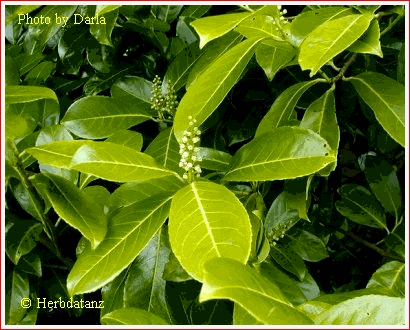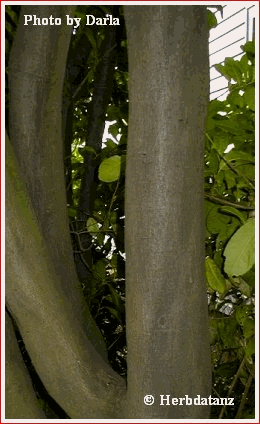
(1) Cherry-laurel
(B.P.C. 1949).
Cherry-laurel
(B.P.C. 1949).
(1) Martindale�s 24th (2)
U.S.D. 1926
Compiled and edited by Ivor Hughes.
Foreign Pharmacopeias: In Belg., Fr. Span, and Swiss.
The fresh leaves of Prunus laurocerasus (Rosaceae), collected as soon as they are fully grown. It contains the glycoside prulaurasin (laurocerasin) which, in the presence of moisture, is decomposed by the enzyme, prunase, with formation of glucose, hydrogen cyanide and benzaldehyde.
Uses. Cherry-laurel is used for the preparation of Cherry-laurel Water, which is used as a flavouring agent and as a sedative in nausea and vomiting. Cherry-laurel Water has also been used, diluted 1 in 10, as an eye lotion.
Cherry-laurel Water (B.P.C. 1949). Aqua Laurocerasi;
Kirschlorbeerwasser. Distilled from cherry-laurel and standardised to
contain 0-1% of HCN. Protect from light in well-filled containers in a cool
place. In Span. P., Belg. P., and Swiss P. The last two require this
to be dispensed when Aqua Amygdalae is prescribed. Dose:
2 to 8 ml. (30 to 120 minims).
(2)
LAUROCERASI FOLIA. Br. CHERRY-LAUREL LEAVES.Cherry-Laurel Leaves are the fresh leaves of Prunus Laurocerasus, Linn.
Br.
English Laurel, Cherry Bay; Laurier-cerise, Fr.; Kirschlorbeer, G.;
Lauroceraso, It.; Laurel-cerezo (Hoja de), Sp.
Prunus Laurocerasus (Fam. Rosaceae) is a small evergreen bush or tree indigenous to Southeastern Europe and Southwestern Asia but cultivated in temperate regions. It attains a height of 10 feet. It possesses long, spreading branches, which, with the trunk, are covered with a smooth, blackish bark. The leaves are oval-oblong, lanceolate, or oblanceolate, petiolate, from five to seven inches in length, acute, finely toothed, firm, coriaceous, smooth, beautifully green and shining, with two to four yellowish glands at the base. The flowers are small, white, strongly odorous, and disposed in simple, axillary or terminal racemes. The fruit is an oval drupe, very similar in shape and structure to a small black cherry.
The leaves are packed in bales and shipped to the United States from Leghorn, Italy and Marseilles, France.In their recent and entire state cherry-laurel leaves are devoid of odor; but, when bruised, they emit the characteristic odor of hydrocyanic acid and bitter almond oil. Their taste is somewhat astringent and strongly bitter, with the flavor of the peach kernel. They are officially described as " thick, coriaceous, on short, strong petioles, oblong or somewhat obovate, from twelve to eighteen centimeters long, tapering towards each end, recurved at the apex, distantly but sharply serrate and slightly revolute at the margins; dark green, smooth and shining above, much paler beneath; midrib prominent, with one or two glandular depressions on the under surface near its base. Inodorous, but emitting when bruised an odor resembling that of prussic acid." Br.
Cherry-laurel leaves are sometimes substituted by the leaves of other species of Prunus. These are readily distinguished in that they do not possess the characteristic glandular hairs which occur on the basal portion of the leaves and petioles of P. Laurocerasus. (B. P. G., 1907, p. 325.) Cherry-laurel leaves contain a glucoside formerly called laurocerasin but now known as prulaurasin which is isomeric with mandelonitrile glucoside, found in wild cherry bark, and related to amygdalin. They contain also a ferment, known as prunase, similar to, if not identical with, emulsin, which causes the decomposition of the glucoside and the formation of hydrocyanic acid and benzaldehyde. As the emulsin is stored in the veins and the prulaurasin found in the parenchyma of the leaf, the production of hydrocyanic acid takes place only after the leaves are broken. One pound, avoirdupois, of the fresh leaves yields 40.5 grains of a volatile oil which resembles that of bitter almonds.
Uses. � Cherry-laurel leaves are used chiefly as a flavoring agent
similar to bitter almond especially in the form of the water. As Broker (B.
F. M. R., 1868) found that the proportion of hydrocyanic acid from the
leaves varies with the season, age of the plant and the character of the
soil and weather, they are inferior for this purpose to the oil of bitter
almond. Several cases of prussic acid poisoning have been reported from
their use. It is not, therefore, to be. regretted that the want of the plant
in this country has prevented the general introduction of so variable a
remedy as the distilled water. (See Aqua Laurocerasi.)
Off. Prep. � Aqua Laurocerasi, Br.
 (2)
AQUA LAUROCERASI. Br. CHERRY-LAUREL
WATER
(2)
AQUA LAUROCERASI. Br. CHERRY-LAUREL
WATER
Hydrolatum Laurocerasi, Eau distillẻe de Laurier-cerise, Fr. Cod.; Kirschlorbeerwasser, G.; Agua destilada de laurel-cerezo, Sp.
Cherry-Laurel Leaves, crushed, 800 grammes; Water, 2500 millilitres. Distil one thousand millilitres; shake the product; filter, if necessary; adjust the strength of the finished product either by adding hydrocyanic acid or Distilled Water, so that, when tested as described under 'Acidum Hydrocyanicum Dilutum,' it contains 0.1 per cent, by weight of hydrocyanic acid, HCN." Br.
The International Protocol (1906) fixed the strength of Cherry-Laurel Water at 0.1 per cent, of hydrocyanic acid . which corresponds with the strength of the Br. Pharm, 1898 and 1914.
It is greatly to be regretted that this uncertain, dangerous, and troublesome preparation should retain a place in European pharmacopoeias, inasmuch as it could easily be replaced by a flavored water containing a definite amount of a soluble cyanide. See S. W. P., 1909, No. 10, 147, and 1909, No. 36, 542.
As the cherry-laurel is little cultivated in the United States, the water is not official; but from several experiments by William Procter there is little or no room to doubt that a preparation identical in its effects might be made from the leaves of our common wild cherry, Prunus serotina. The imported cherry-laurel water, as found in commerce, is generally impaired by age, and not to be relied on.
Cherry-laurel leaves contain 65 per cent, of water, sufficient to provoke the reaction which results in the formation of a volatile oil and hydrocyanic acid. Water is very prone to hasten the conversion of the benzaldehyde, contained in the volatile oil, into benzoic acid by oxidation, and it has been found by C. Umney (P. J., x, 467) and by Moore (Ibid., 604) that the water distilled without previous maceration is somewhat stronger in hydrocyanic acid and decidedly stronger in oil (Umney) than the official product. The strength of cherry-laurel water was formerly very variable, but the British Pharmacopoeia requires 0.1 per cent, of hydrocyanic acid. The proportion of hydrocyanic acid in the water diminishes with time. It has been ascertained by Deschamps that if a drop of sulphuric acid be added to a pint of the preparation it will keep unchanged for at least a year. It is best preserved by the entire exclusion of air and light. Lepage found that, preserved in full and perfectly air-tight bottles, both this and bitter almond water remained unchanged at the end of a year; while if freely exposed to the air, they lost all their hydrocyanic acid and essential oil in two or three months. (J. P. C., xvi, 346.) For Deniges' method of assaying the water, see Proc. A. Ph. A., 1894, 556.
Uses. � Cherry-laurel water is employed in Europe as a sedative narcotic, identical in its properties with a diluted solution of hydrocyanic acid; but it is of uncertain strength, and should not be allowed to supersede the preparation of the acid now in use.
Dose
, twenty minims to a fluidrachm (1.3 - 3.75 cc.).If you did not find what you were seeking please use the site search box at the top right hand of the page or else peruse the site library
![]()